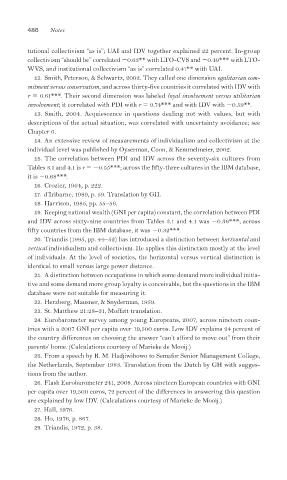Page 521 - Cultures and Organizations
P. 521
486 Notes
tutional collectivism “as is”; UAI and IDV together explained 22 percent. In-group
collectivism “should be” correlated 0.63** with LTO-CVS and 0.49*** with LTO-
WVS, and institutional collectivism “as is” correlated 0.41** with UAI.
12. Smith, Peterson, & Schwartz, 2002. They called one dimension egalitarian com-
mitment versus conservatism, and across thirty-five countries it correlated with IDV with
r 0.61***. Their second dimension was labeled loyal involvement versus utilitarian
involvement; it correlated with PDI with r 0.74*** and with IDV with 0.59**.
13. Smith, 2004. Acquiescence in questions dealing not with values, but with
descriptions of the actual situation, was correlated with uncertainty avoidance; see
Chapter 6.
14. An extensive review of measurements of individualism and collectivism at the
individual level was published by Oyserman, Coon, & Kemmelmeier, 2002.
15. The correlation between PDI and IDV across the seventy-six cultures from
Tables 3.1 and 4.1 is r 0.55***; across the fifty-three cultures in the IBM database,
it is 0.68***.
16. Crozier, 1964, p. 222.
17. d’Iribarne, 1989, p. 59. Translation by GH.
18. Harrison, 1985, pp. 55–56.
19. Keeping national wealth (GNI per capita) constant, the correlation between PDI
and IDV across sixty-nine countries from Tables 3.1 and 4.1 was 0.36***; across
fifty countries from the IBM database, it was 0.32***.
20. Triandis (1995, pp. 44–52) has introduced a distinction between horizontal and
vertical individualism and collectivism. He applies this distinction mostly at the level
of individuals. At the level of societies, the horizontal versus vertical distinction is
identical to small versus large power distance.
21. A distinction between occupations in which some demand more individual initia-
tive and some demand more group loyalty is conceivable, but the questions in the IBM
database were not suitable for measuring it.
22. Herzberg, Mausner, & Snyderman, 1959.
23. St. Matthew 21:28–31, Moffatt translation.
24. Eurobarometer survey among young Europeans, 2007, across nineteen coun-
tries with a 2007 GNI per capita over 19,500 euros. Low IDV explains 24 percent of
the country differences on choosing the answer “can’t afford to move out” from their
parents’ home. (Calculations courtesy of Marieke de Mooij.)
25. From a speech by R. M. Hadjiwibowo to Semafor Senior Management College,
the Netherlands, September 1983. Translation from the Dutch by GH with sugges-
tions from the author.
26. Flash Eurobarometer 241, 2008. Across nineteen European countries with GNI
per capita over 19,500 euros, 72 percent of the differences in answering this question
are explained by low IDV. (Calculations courtesy of Marieke de Mooij.)
27. Hall, 1976.
28. Ho, 1976, p. 867.
29. Triandis, 1972, p. 38.

